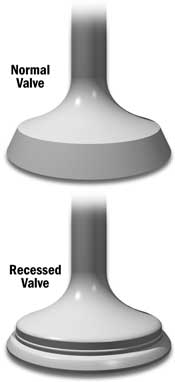Does anyone have any interesting theories as to what causes valve recession?
Interestingly, I've only ever come across it occuring on inlet valves.
Does anyone have any interesting theories as to what causes valve recession?
Interestingly, I've only ever come across it occuring on inlet valves.
Which sort? The seat insert sinking deeper into an alloy head or the seat itself getting eroded away?
The second became more of a problem on exhaust seats when unleaded petrol came along. But I stopped being concerned about such things about then.
Go soothingly on the grease mud, as there lurks the skid demon
Also
Notice the valve gear rotates. Thats where lead was so effective in minimising the scuffing.
Nowdays the material spec of the valve vs the seat gets to deal with things
"I don't like it, and I'm sorry I ever had anything to do with it." -- Erwin Schrodinger talking about quantum mechanics.
I've seen both. My KTM head is currently on the bench waiting for new valves, the intakes were worn beyond what I considerd recoverable. Got some nitrided stainless steel jobs for it.
I worked with an aircraft engine builder once, they had issues with valve and seat wear relating to the effects of various additives in different fuels well before the general automotive industry did. He explained it as almost a micro-forging of metalic wear particles into the seat face, welding the valve to the seat. The valve lifting again tore the welded patch apart. Made sense of what I saw in those days, and I'd say whether the wear was on the seat or the valve probably depended on the respective materials.
Go soothingly on the grease mud, as there lurks the skid demon
This is the type of wear I'm referring to.

Yep, that's it.
Although in passing; that is not what I'd call a "normal" valve profile.
Go soothingly on the grease mud, as there lurks the skid demon
Looks like a Cluedo piece.
My theory would be the valve being made of a softer material and the valve being exposed more directly to heat than the seat, the seat has more ability to absorb impacts because the energy can be channeled away from it, whereas the valve cannot.
But, I'm no genius.
You're right there, but they're only cool when the intake charge enters the cylinder, but I suppose that debunks my heat theory. Damn.
Could cam ramp profiles have anything to do with it, or it could purely be the lack of lead?
I vote: Two similar motors with fresh valves (two GN250s or some other cheap shit), run one on lead additive and one on normal 95, compare after X distance. I'll supply one of them
Go soothingly on the grease mud, as there lurks the skid demon
I find myself wondering whether inlet valves are made with the same carbon content that exhaust valves are.
Speaking from past experience with the coal burner, 1981 TR1/ XV 1000cc, for novices.
After 107,000 K's she needed 1 new valve guide insert.
All valve seats were re-cut and lapped in ( yep they still do that).
Nothing else, no apparent excessive wear and I've run her on 91 No Lead for last 4 years or the last 30 odd Thousand K's.
When I did run some lead additive because someone else with a similar age bike did, it seemed to upset her terribly, so I stopped using it.
Have heard anecdotally that this is actually becoming more of a problem than most might have expected.
Mates in engine reconditioning areas in cars, boats and aircraft.
Perhaps they're just not making valve stems as hard as they used to Katman?
Every day above ground is a good day!:
Ive been told it can happen due to aggressive cam profiles where the cam follower comes away from the cam as the profile drops. This causes the valve seating speed to be excessively high.
Not sure if this is true or BS but another way of looking at it I guess.
There are currently 1 users browsing this thread. (0 members and 1 guests)
Bookmarks